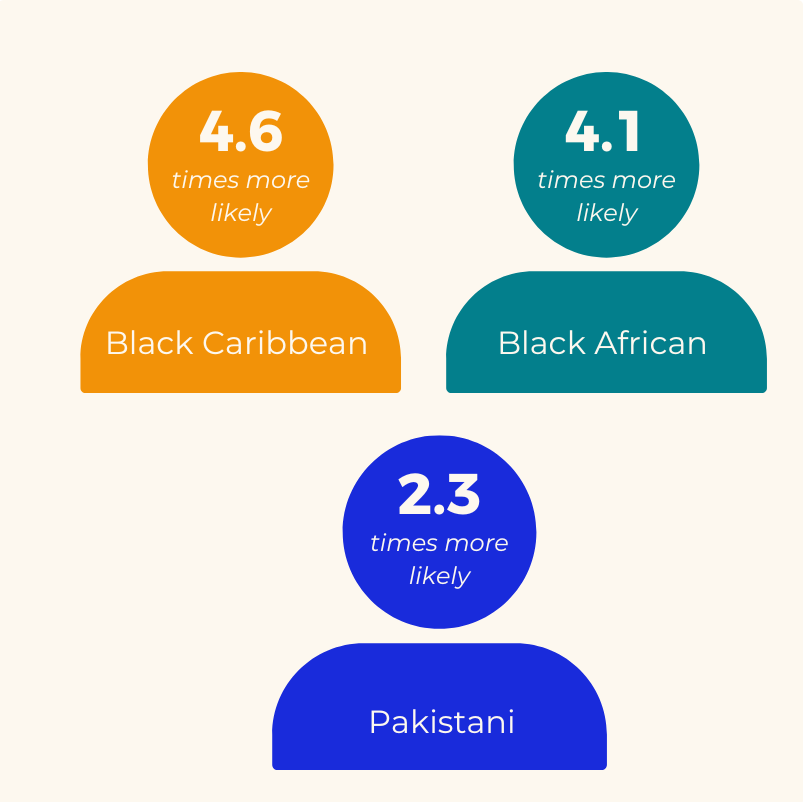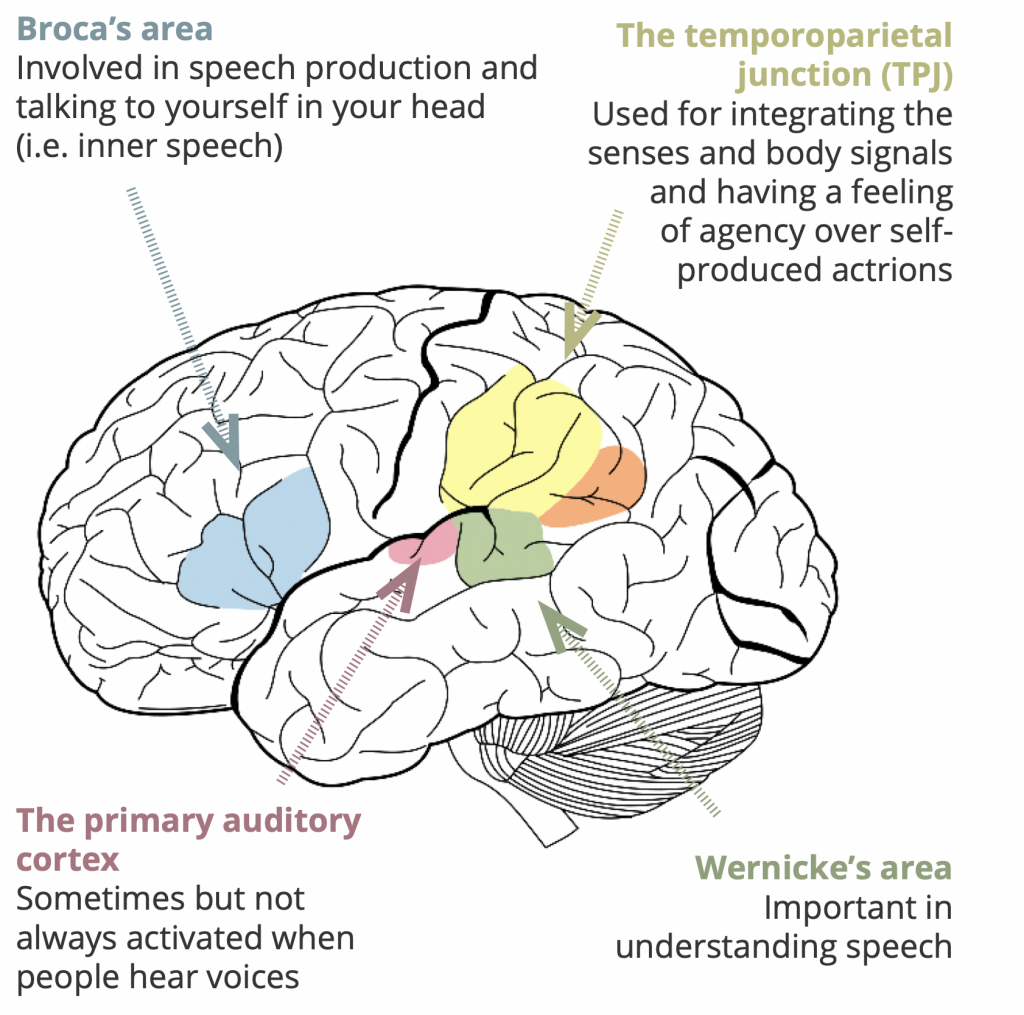Why do some people hear voices?
Here we take a brief look at some scientific theories about why people hear voices. These explanations aren’t presented in any particular order, don’t exclude each other, and they all have pros and cons.
There are plenty of other explanations for voice-hearing – for example, some voices are an important aspect of spirituality or creativity. If you want information on this, see the links at the bottom of the page.
1. Some voices are linked to inner speech
Most of us talk to ourselves in our heads. For example, you might say to yourself ‘Remember to buy milk’ while heading out in the morning. This is called inner speech and some scientists think it is linked to voice-hearing.
The theory says that a person hears a voice when they have actually talked to themselves in inner speech, but for some reason don’t recognize these thoughts as their own. The result is that a bit of inner speech that was actually produced by you becomes attributed to another person or voice.
If voices are inner speech, why don't people recognise them as their own?
- Sometimes a person’s inner speech doesn’t sound like them. When this occurs, it is easier to understand how it could be experienced as coming from somewhere else.
- Stress or strain. Sleep deprivation, drugs and alcohol, or major life stresses can make it easier to make thinking errors.
- Inner speech can be intrusive. When thoughts just ‘pop into our heads’, they are more likely to be attributed to someone else.
- Unacceptable ideas. Sometimes people find the content of their thoughts so unacceptable that they are sure that they are ‘not me’.
What's the evidence?
- Brain scanning studies have shown that voice-hearing activates the same part of the brain we use for speaking
- Muscles around the mouth have been found to move when a person is hearing voices. This also happens when a person is doing inner speech.
2. Voices can be responses to trauma
The evidence of a link between childhood misfortune and future psychotic disorder is about as strong statistically as the link between smoking and lung cancer
Some types of voices are best understood as having their roots in memories of traumatic life experiences, particularly those that occur in childhood. This could be things like neglect, bullying, physical, sexual and emotional abuse.
%
People with a history of childhood trauma are 3 times more likely to develop psychosis
Some people report voices and other unusual experiences that are like ‘flash backs’ or memories that directly replay or echo the traumatic event. For others, the link is more complicated. For example, a survivor of childhood abuse struggling with shame and other negative feelings might hear a voice saying they are worthless or telling them to do dangerous or unacceptable things.
Voices in response to trauma aren’t always so frightening, though. Sometimes people hear a supportive or guiding voice that helps them get through difficult and traumatic times.
3. Social and environmental factors can play a role
Voice-hearing can also be linked to things that happen in our lives – both to us and in the places we live. These include money worries, access to school and work, and community problems.
Recent research in London found that poverty and deprivation can increase a person’s risk of developing psychosis, as can living in a city as opposed to a rural area. Inequality is also a contributing factor. Poor people living in neighbourhoods where richer people also live tend to have a greater risk of developing psychotic experiences – like voices – than those living in neighbourhoods where most people have a similar income.
People from minority ethnic groups living in the UK are much more likely than white British people to be diagnosed with psychosis or schizophrenia. Social exclusion, discrimination, everyday and institutional racism all contribute to the problem.
4. What’s happening in the brain is relevant too …
Did you know?
Scientists now think of the brain as a ‘prediction machine’ whose main job is not to process information coming from outside, but instead to predict what is happening in the world and adjust those predictions on the basis of new information. The theory holds that usually there is often too much information for the brain to take in, so we take a shortcuts or ‘fill in the gaps’. How we fill in the gaps might be based on past experiences and what we have learned to expect about the world.
This means that if you get used to there being particular threats around you – e.g. snide comments, whispers, or outright abuse – your brain might start ‘filling in the gaps’ with those expectations. In some cases, this might lead to hearing unpleasant voices; in others, it could result in seeing a dark shadow, or feeling like someone is touching or pushing you.
Find out more
The following resources might be useful for anyone with an interest in scientific explanations of voice-hearing:
If you’d like information on other reasons why someone might hear voices, take a look at:
References
Ben Alderson-Day and Charles Fernyhough (2015). Inner speech: Development, cognitive functions, phenomenology, and neurobiology. Psychological Bulletin, 141(5), 931-965. doi: 10.1037/bul0000021.
Alderson-Day et al (2016). The brain’s conversation with itself: Neural substrates of dialogic inner speech. Social Cognitive & Affective Neuroscience, Vol. 11, Issue 1. doi: 10.1093/scan/nsv094.
Varese et al (2012). Childhood adversities increase the risk of psychosis: a meta-analysis of patient-control, prospective- and cross-sectional cohort studies. Schizophrenia bulletin, Vol. 38, Issue 4, 661-71. doi: 10.1093/schbul/sbs050.
Kirkbride et al (2017). Ethnic Minority Status, Age-at-Immigration and Psychosis Risk in Rural Environments: Evidence From the SEPEA Study. Schizophrenia Bulletin, Vol. 43, Issue 6. doi: 10.1093/schbul/sbx010.



